2005 MERCEDES-BENZ SPRINTER fuse box
[x] Cancel search: fuse boxPage 120 of 1232
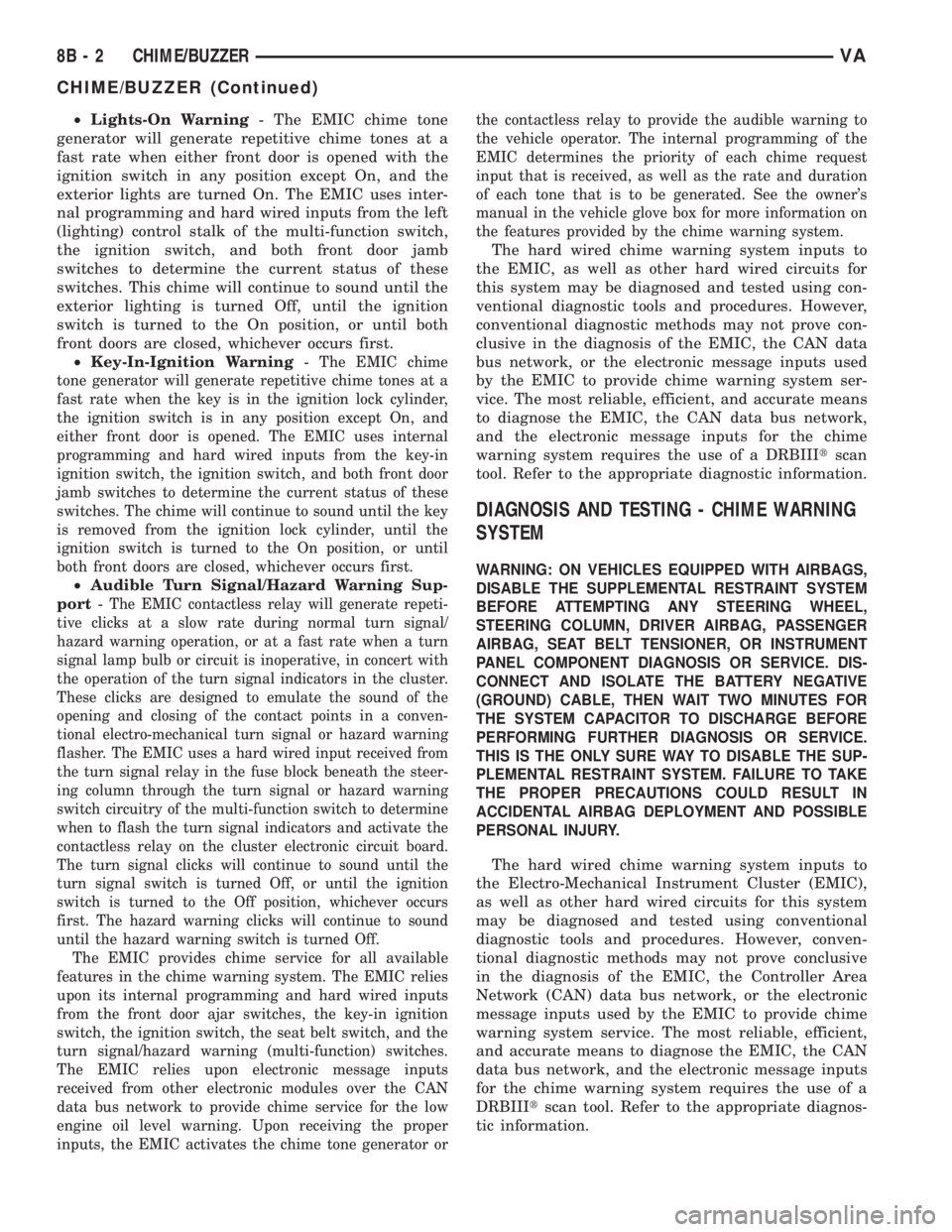
²Lights-On Warning- The EMIC chime tone
generator will generate repetitive chime tones at a
fast rate when either front door is opened with the
ignition switch in any position except On, and the
exterior lights are turned On. The EMIC uses inter-
nal programming and hard wired inputs from the left
(lighting) control stalk of the multi-function switch,
the ignition switch, and both front door jamb
switches to determine the current status of these
switches. This chime will continue to sound until the
exterior lighting is turned Off, until the ignition
switch is turned to the On position, or until both
front doors are closed, whichever occurs first.
²Key-In-Ignition Warning-
The EMIC chime
tone generator will generate repetitive chime tones at a
fast rate when the key is in the ignition lock cylinder,
the ignition switch is in any position except On, and
either front door is opened. The EMIC uses internal
programming and hard wired inputs from the key-in
ignition switch, the ignition switch, and both front door
jamb switches to determine the current status of these
switches. The chime will continue to sound until the key
is removed from the ignition lock cylinder, until the
ignition switch is turned to the On position, or until
both front doors are closed, whichever occurs first.
²Audible Turn Signal/Hazard Warning Sup-
port-
The EMIC contactless relay will generate repeti-
tive clicks at a slow rate during normal turn signal/
hazard warning operation, or at a fast rate when a turn
signal lamp bulb or circuit is inoperative, in concert with
the operation of the turn signal indicators in the cluster.
These clicks are designed to emulate the sound of the
opening and closing of the contact points in a conven-
tional electro-mechanical turn signal or hazard warning
flasher. The EMIC uses a hard wired input received from
the turn signal relay in the fuse block beneath the steer-
ing column through the turn signal or hazard warning
switch circuitry of the multi-function switch to determine
when to flash the turn signal indicators and activate the
contactless relay on the cluster electronic circuit board.
The turn signal clicks will continue to sound until the
turn signal switch is turned Off, or until the ignition
switch is turned to the Off position, whichever occurs
first. The hazard warning clicks will continue to sound
until the hazard warning switch is turned Off.
The EMIC provides chime service for all available
features in the chime warning system. The EMIC relies
upon its internal programming and hard wired inputs
from the front door ajar switches, the key-in ignition
switch, the ignition switch, the seat belt switch, and the
turn signal/hazard warning (multi-function) switches.
The EMIC relies upon electronic message inputs
received from other electronic modules over the CAN
data bus network to provide chime service for the low
engine oil level warning. Upon receiving the proper
inputs, the EMIC activates the chime tone generator orthe contactless relay to provide the audible warning to
the vehicle operator. The internal programming of the
EMIC determines the priority of each chime request
input that is received, as well as the rate and duration
of each tone that is to be generated. See the owner's
manual in the vehicle glove box for more information on
the features provided by the chime warning system.
The hard wired chime warning system inputs to
the EMIC, as well as other hard wired circuits for
this system may be diagnosed and tested using con-
ventional diagnostic tools and procedures. However,
conventional diagnostic methods may not prove con-
clusive in the diagnosis of the EMIC, the CAN data
bus network, or the electronic message inputs used
by the EMIC to provide chime warning system ser-
vice. The most reliable, efficient, and accurate means
to diagnose the EMIC, the CAN data bus network,
and the electronic message inputs for the chime
warning system requires the use of a DRBIIItscan
tool. Refer to the appropriate diagnostic information.
DIAGNOSIS AND TESTING - CHIME WARNING
SYSTEM
WARNING: ON VEHICLES EQUIPPED WITH AIRBAGS,
DISABLE THE SUPPLEMENTAL RESTRAINT SYSTEM
BEFORE ATTEMPTING ANY STEERING WHEEL,
STEERING COLUMN, DRIVER AIRBAG, PASSENGER
AIRBAG, SEAT BELT TENSIONER, OR INSTRUMENT
PANEL COMPONENT DIAGNOSIS OR SERVICE. DIS-
CONNECT AND ISOLATE THE BATTERY NEGATIVE
(GROUND) CABLE, THEN WAIT TWO MINUTES FOR
THE SYSTEM CAPACITOR TO DISCHARGE BEFORE
PERFORMING FURTHER DIAGNOSIS OR SERVICE.
THIS IS THE ONLY SURE WAY TO DISABLE THE SUP-
PLEMENTAL RESTRAINT SYSTEM. FAILURE TO TAKE
THE PROPER PRECAUTIONS COULD RESULT IN
ACCIDENTAL AIRBAG DEPLOYMENT AND POSSIBLE
PERSONAL INJURY.
The hard wired chime warning system inputs to
the Electro-Mechanical Instrument Cluster (EMIC),
as well as other hard wired circuits for this system
may be diagnosed and tested using conventional
diagnostic tools and procedures. However, conven-
tional diagnostic methods may not prove conclusive
in the diagnosis of the EMIC, the Controller Area
Network (CAN) data bus network, or the electronic
message inputs used by the EMIC to provide chime
warning system service. The most reliable, efficient,
and accurate means to diagnose the EMIC, the CAN
data bus network, and the electronic message inputs
for the chime warning system requires the use of a
DRBIIItscan tool. Refer to the appropriate diagnos-
tic information.
8B - 2 CHIME/BUZZERVA
CHIME/BUZZER (Continued)
Page 175 of 1232
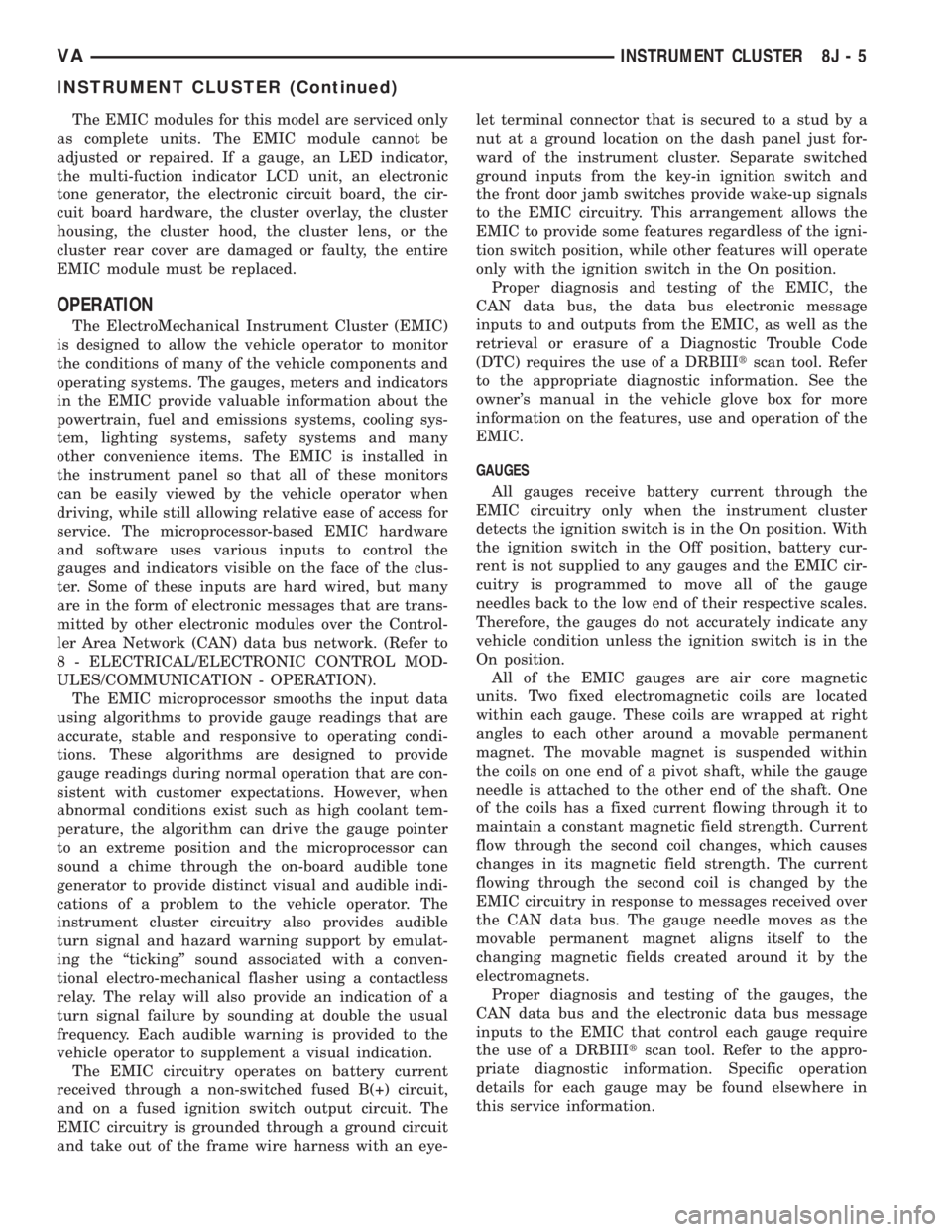
The EMIC modules for this model are serviced only
as complete units. The EMIC module cannot be
adjusted or repaired. If a gauge, an LED indicator,
the multi-fuction indicator LCD unit, an electronic
tone generator, the electronic circuit board, the cir-
cuit board hardware, the cluster overlay, the cluster
housing, the cluster hood, the cluster lens, or the
cluster rear cover are damaged or faulty, the entire
EMIC module must be replaced.
OPERATION
The ElectroMechanical Instrument Cluster (EMIC)
is designed to allow the vehicle operator to monitor
the conditions of many of the vehicle components and
operating systems. The gauges, meters and indicators
in the EMIC provide valuable information about the
powertrain, fuel and emissions systems, cooling sys-
tem, lighting systems, safety systems and many
other convenience items. The EMIC is installed in
the instrument panel so that all of these monitors
can be easily viewed by the vehicle operator when
driving, while still allowing relative ease of access for
service. The microprocessor-based EMIC hardware
and software uses various inputs to control the
gauges and indicators visible on the face of the clus-
ter. Some of these inputs are hard wired, but many
are in the form of electronic messages that are trans-
mitted by other electronic modules over the Control-
ler Area Network (CAN) data bus network. (Refer to
8 - ELECTRICAL/ELECTRONIC CONTROL MOD-
ULES/COMMUNICATION - OPERATION).
The EMIC microprocessor smooths the input data
using algorithms to provide gauge readings that are
accurate, stable and responsive to operating condi-
tions. These algorithms are designed to provide
gauge readings during normal operation that are con-
sistent with customer expectations. However, when
abnormal conditions exist such as high coolant tem-
perature, the algorithm can drive the gauge pointer
to an extreme position and the microprocessor can
sound a chime through the on-board audible tone
generator to provide distinct visual and audible indi-
cations of a problem to the vehicle operator. The
instrument cluster circuitry also provides audible
turn signal and hazard warning support by emulat-
ing the ªtickingº sound associated with a conven-
tional electro-mechanical flasher using a contactless
relay. The relay will also provide an indication of a
turn signal failure by sounding at double the usual
frequency. Each audible warning is provided to the
vehicle operator to supplement a visual indication.
The EMIC circuitry operates on battery current
received through a non-switched fused B(+) circuit,
and on a fused ignition switch output circuit. The
EMIC circuitry is grounded through a ground circuit
and take out of the frame wire harness with an eye-let terminal connector that is secured to a stud by a
nut at a ground location on the dash panel just for-
ward of the instrument cluster. Separate switched
ground inputs from the key-in ignition switch and
the front door jamb switches provide wake-up signals
to the EMIC circuitry. This arrangement allows the
EMIC to provide some features regardless of the igni-
tion switch position, while other features will operate
only with the ignition switch in the On position.
Proper diagnosis and testing of the EMIC, the
CAN data bus, the data bus electronic message
inputs to and outputs from the EMIC, as well as the
retrieval or erasure of a Diagnostic Trouble Code
(DTC) requires the use of a DRBIIItscan tool. Refer
to the appropriate diagnostic information. See the
owner's manual in the vehicle glove box for more
information on the features, use and operation of the
EMIC.
GAUGES
All gauges receive battery current through the
EMIC circuitry only when the instrument cluster
detects the ignition switch is in the On position. With
the ignition switch in the Off position, battery cur-
rent is not supplied to any gauges and the EMIC cir-
cuitry is programmed to move all of the gauge
needles back to the low end of their respective scales.
Therefore, the gauges do not accurately indicate any
vehicle condition unless the ignition switch is in the
On position.
All of the EMIC gauges are air core magnetic
units. Two fixed electromagnetic coils are located
within each gauge. These coils are wrapped at right
angles to each other around a movable permanent
magnet. The movable magnet is suspended within
the coils on one end of a pivot shaft, while the gauge
needle is attached to the other end of the shaft. One
of the coils has a fixed current flowing through it to
maintain a constant magnetic field strength. Current
flow through the second coil changes, which causes
changes in its magnetic field strength. The current
flowing through the second coil is changed by the
EMIC circuitry in response to messages received over
the CAN data bus. The gauge needle moves as the
movable permanent magnet aligns itself to the
changing magnetic fields created around it by the
electromagnets.
Proper diagnosis and testing of the gauges, the
CAN data bus and the electronic data bus message
inputs to the EMIC that control each gauge require
the use of a DRBIIItscan tool. Refer to the appro-
priate diagnostic information. Specific operation
details for each gauge may be found elsewhere in
this service information.
VAINSTRUMENT CLUSTER 8J - 5
INSTRUMENT CLUSTER (Continued)
Page 287 of 1232
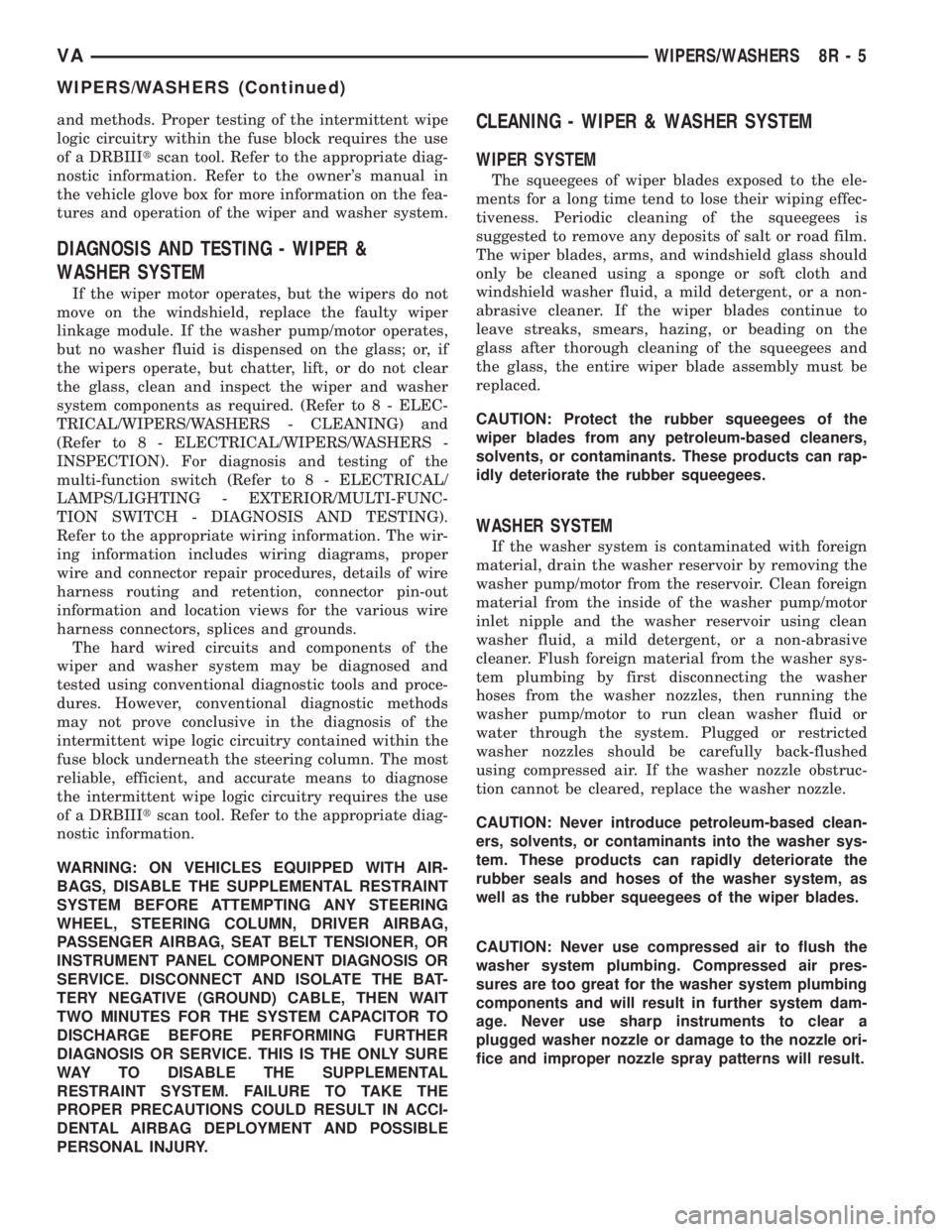
and methods. Proper testing of the intermittent wipe
logic circuitry within the fuse block requires the use
of a DRBIIItscan tool. Refer to the appropriate diag-
nostic information. Refer to the owner's manual in
the vehicle glove box for more information on the fea-
tures and operation of the wiper and washer system.
DIAGNOSIS AND TESTING - WIPER &
WASHER SYSTEM
If the wiper motor operates, but the wipers do not
move on the windshield, replace the faulty wiper
linkage module. If the washer pump/motor operates,
but no washer fluid is dispensed on the glass; or, if
the wipers operate, but chatter, lift, or do not clear
the glass, clean and inspect the wiper and washer
system components as required. (Refer to 8 - ELEC-
TRICAL/WIPERS/WASHERS - CLEANING) and
(Refer to 8 - ELECTRICAL/WIPERS/WASHERS -
INSPECTION). For diagnosis and testing of the
multi-function switch (Refer to 8 - ELECTRICAL/
LAMPS/LIGHTING - EXTERIOR/MULTI-FUNC-
TION SWITCH - DIAGNOSIS AND TESTING).
Refer to the appropriate wiring information. The wir-
ing information includes wiring diagrams, proper
wire and connector repair procedures, details of wire
harness routing and retention, connector pin-out
information and location views for the various wire
harness connectors, splices and grounds.
The hard wired circuits and components of the
wiper and washer system may be diagnosed and
tested using conventional diagnostic tools and proce-
dures. However, conventional diagnostic methods
may not prove conclusive in the diagnosis of the
intermittent wipe logic circuitry contained within the
fuse block underneath the steering column. The most
reliable, efficient, and accurate means to diagnose
the intermittent wipe logic circuitry requires the use
of a DRBIIItscan tool. Refer to the appropriate diag-
nostic information.
WARNING: ON VEHICLES EQUIPPED WITH AIR-
BAGS, DISABLE THE SUPPLEMENTAL RESTRAINT
SYSTEM BEFORE ATTEMPTING ANY STEERING
WHEEL, STEERING COLUMN, DRIVER AIRBAG,
PASSENGER AIRBAG, SEAT BELT TENSIONER, OR
INSTRUMENT PANEL COMPONENT DIAGNOSIS OR
SERVICE. DISCONNECT AND ISOLATE THE BAT-
TERY NEGATIVE (GROUND) CABLE, THEN WAIT
TWO MINUTES FOR THE SYSTEM CAPACITOR TO
DISCHARGE BEFORE PERFORMING FURTHER
DIAGNOSIS OR SERVICE. THIS IS THE ONLY SURE
WAY TO DISABLE THE SUPPLEMENTAL
RESTRAINT SYSTEM. FAILURE TO TAKE THE
PROPER PRECAUTIONS COULD RESULT IN ACCI-
DENTAL AIRBAG DEPLOYMENT AND POSSIBLE
PERSONAL INJURY.
CLEANING - WIPER & WASHER SYSTEM
WIPER SYSTEM
The squeegees of wiper blades exposed to the ele-
ments for a long time tend to lose their wiping effec-
tiveness. Periodic cleaning of the squeegees is
suggested to remove any deposits of salt or road film.
The wiper blades, arms, and windshield glass should
only be cleaned using a sponge or soft cloth and
windshield washer fluid, a mild detergent, or a non-
abrasive cleaner. If the wiper blades continue to
leave streaks, smears, hazing, or beading on the
glass after thorough cleaning of the squeegees and
the glass, the entire wiper blade assembly must be
replaced.
CAUTION: Protect the rubber squeegees of the
wiper blades from any petroleum-based cleaners,
solvents, or contaminants. These products can rap-
idly deteriorate the rubber squeegees.
WASHER SYSTEM
If the washer system is contaminated with foreign
material, drain the washer reservoir by removing the
washer pump/motor from the reservoir. Clean foreign
material from the inside of the washer pump/motor
inlet nipple and the washer reservoir using clean
washer fluid, a mild detergent, or a non-abrasive
cleaner. Flush foreign material from the washer sys-
tem plumbing by first disconnecting the washer
hoses from the washer nozzles, then running the
washer pump/motor to run clean washer fluid or
water through the system. Plugged or restricted
washer nozzles should be carefully back-flushed
using compressed air. If the washer nozzle obstruc-
tion cannot be cleared, replace the washer nozzle.
CAUTION: Never introduce petroleum-based clean-
ers, solvents, or contaminants into the washer sys-
tem. These products can rapidly deteriorate the
rubber seals and hoses of the washer system, as
well as the rubber squeegees of the wiper blades.
CAUTION: Never use compressed air to flush the
washer system plumbing. Compressed air pres-
sures are too great for the washer system plumbing
components and will result in further system dam-
age. Never use sharp instruments to clear a
plugged washer nozzle or damage to the nozzle ori-
fice and improper nozzle spray patterns will result.
VAWIPERS/WASHERS 8R - 5
WIPERS/WASHERS (Continued)
Page 1212 of 1232
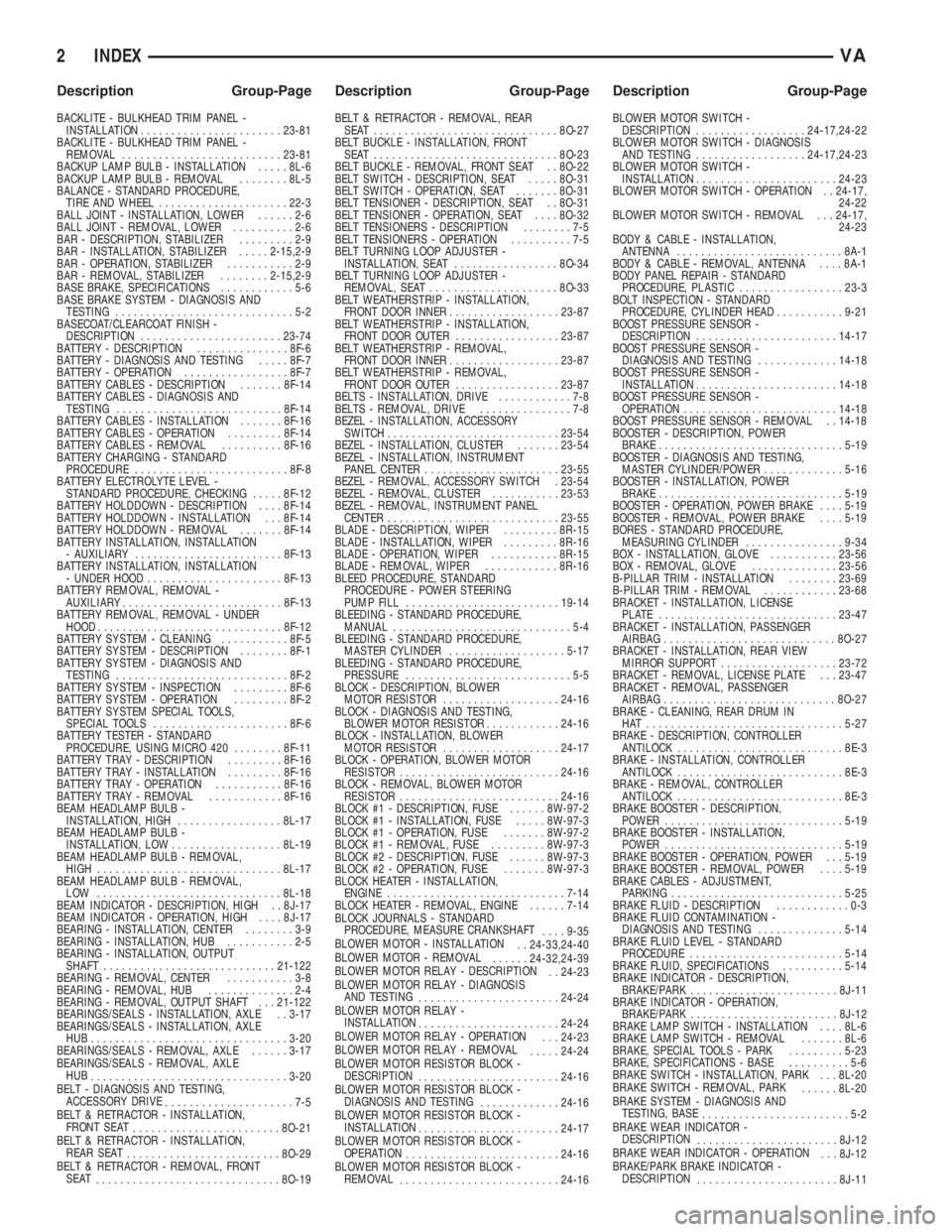
BACKLITE - BULKHEAD TRIM PANEL -
INSTALLATION.......................23-81
BACKLITE - BULKHEAD TRIM PANEL -
REMOVAL..........................23-81
BACKUP LAMP BULB - INSTALLATION.....8L-6
BACKUP LAMP BULB - REMOVAL........8L-5
BALANCE - STANDARD PROCEDURE,
TIRE AND WHEEL.....................22-3
BALL JOINT - INSTALLATION, LOWER......2-6
BALL JOINT - REMOVAL, LOWER..........2-6
BAR - DESCRIPTION, STABILIZER.........2-9
BAR - INSTALLATION, STABILIZER.....2-15,2-9
BAR - OPERATION, STABILIZER...........2-9
BAR - REMOVAL, STABILIZER........2-15,2-9
BASE BRAKE, SPECIFICATIONS............5-6
BASE BRAKE SYSTEM - DIAGNOSIS AND
TESTING.............................5-2
BASECOAT/CLEARCOAT FINISH -
DESCRIPTION.......................23-74
BATTERY - DESCRIPTION...............8F-6
BATTERY - DIAGNOSIS AND TESTING.....8F-7
BATTERY - OPERATION.................8F-7
BATTERY CABLES - DESCRIPTION.......8F-14
BATTERY CABLES - DIAGNOSIS AND
TESTING...........................8F-14
BATTERY CABLES - INSTALLATION.......8F-16
BATTERY CABLES - OPERATION.........8F-14
BATTERY CABLES - REMOVAL..........8F-16
BATTERY CHARGING - STANDARD
PROCEDURE.........................8F-8
BATTERY ELECTROLYTE LEVEL -
STANDARD PROCEDURE, CHECKING.....8F-12
BATTERY HOLDDOWN - DESCRIPTION....8F-14
BATTERY HOLDDOWN - INSTALLATION . . . 8F-14
BATTERY HOLDDOWN - REMOVAL.......8F-14
BATTERY INSTALLATION, INSTALLATION
- AUXILIARY........................8F-13
BATTERY INSTALLATION, INSTALLATION
- UNDER HOOD......................8F-13
BATTERY REMOVAL, REMOVAL -
AUXILIARY..........................8F-13
BATTERY REMOVAL, REMOVAL - UNDER
HOOD..............................8F-12
BATTERY SYSTEM - CLEANING...........8F-5
BATTERY SYSTEM - DESCRIPTION........8F-1
BATTERY SYSTEM - DIAGNOSIS AND
TESTING............................8F-2
BATTERY SYSTEM - INSPECTION.........8F-6
BATTERY SYSTEM - OPERATION.........8F-2
BATTERY SYSTEM SPECIAL TOOLS,
SPECIAL TOOLS......................8F-6
BATTERY TESTER - STANDARD
PROCEDURE, USING MICRO 420........8F-11
BATTERY TRAY - DESCRIPTION.........8F-16
BATTERY TRAY - INSTALLATION.........8F-16
BATTERY TRAY - OPERATION...........8F-16
BATTERY TRAY - REMOVAL............8F-16
BEAM HEADLAMP BULB -
INSTALLATION, HIGH.................8L-17
BEAM HEADLAMP BULB -
INSTALLATION, LOW..................8L-19
BEAM HEADLAMP BULB - REMOVAL,
HIGH..............................8L-17
BEAM HEADLAMP BULB - REMOVAL,
LOW ..............................8L-18
BEAM INDICATOR - DESCRIPTION, HIGH . . 8J-17
BEAM INDICATOR - OPERATION, HIGH....8J-17
BEARING - INSTALLATION, CENTER........3-9
BEARING - INSTALLATION, HUB...........2-5
BEARING - INSTALLATION, OUTPUT
SHAFT............................21-122
BEARING - REMOVAL, CENTER...........3-8
BEARING - REMOVAL, HUB..............2-4
BEARING - REMOVAL, OUTPUT SHAFT . . . 21-122
BEARINGS/SEALS - INSTALLATION, AXLE . . 3-17
BEARINGS/SEALS - INSTALLATION, AXLE
HUB................................3-20
BEARINGS/SEALS - REMOVAL, AXLE......3-17
BEARINGS/SEALS - REMOVAL, AXLE
HUB
................................3-20
BELT - DIAGNOSIS AND TESTING,
ACCESSORY DRIVE
.....................7-5
BELT & RETRACTOR - INSTALLATION,
FRONT SEAT
........................8O-21
BELT & RETRACTOR - INSTALLATION,
REAR SEAT
.........................8O-29
BELT & RETRACTOR - REMOVAL, FRONT
SEAT
..............................8O-19BELT & RETRACTOR - REMOVAL, REAR
SEAT ..............................8O-27
BELT BUCKLE - INSTALLATION, FRONT
SEAT ..............................8O-23
BELT BUCKLE - REMOVAL, FRONT SEAT . . 8O-22
BELT SWITCH - DESCRIPTION, SEAT.....8O-31
BELT SWITCH - OPERATION, SEAT.......8O-31
BELT TENSIONER - DESCRIPTION, SEAT . . 8O-31
BELT TENSIONER - OPERATION, SEAT....8O-32
BELT TENSIONERS - DESCRIPTION........7-5
BELT TENSIONERS - OPERATION..........7-5
BELT TURNING LOOP ADJUSTER -
INSTALLATION, SEAT.................8O-34
BELT TURNING LOOP ADJUSTER -
REMOVAL, SEAT.....................8O-33
BELT WEATHERSTRIP - INSTALLATION,
FRONT DOOR INNER..................23-87
BELT WEATHERSTRIP - INSTALLATION,
FRONT DOOR OUTER.................23-87
BELT WEATHERSTRIP - REMOVAL,
FRONT DOOR INNER..................23-87
BELT WEATHERSTRIP - REMOVAL,
FRONT DOOR OUTER.................23-87
BELTS - INSTALLATION, DRIVE............7-8
BELTS - REMOVAL, DRIVE...............7-8
BEZEL - INSTALLATION, ACCESSORY
SWITCH............................23-54
BEZEL - INSTALLATION, CLUSTER.......23-54
BEZEL - INSTALLATION, INSTRUMENT
PANEL CENTER......................23-55
BEZEL - REMOVAL, ACCESSORY SWITCH . 23-54
BEZEL - REMOVAL, CLUSTER...........23-53
BEZEL - REMOVAL, INSTRUMENT PANEL
CENTER............................23-55
BLADE - DESCRIPTION, WIPER.........8R-15
BLADE - INSTALLATION, WIPER.........8R-16
BLADE - OPERATION, WIPER...........8R-15
BLADE - REMOVAL, WIPER............8R-16
BLEED PROCEDURE, STANDARD
PROCEDURE - POWER STEERING
PUMP FILL.........................19-14
BLEEDING - STANDARD PROCEDURE,
MANUAL.............................5-4
BLEEDING - STANDARD PROCEDURE,
MASTER CYLINDER...................5-17
BLEEDING - STANDARD PROCEDURE,
PRESSURE...........................5-5
BLOCK - DESCRIPTION, BLOWER
MOTOR RESISTOR...................24-16
BLOCK - DIAGNOSIS AND TESTING,
BLOWER MOTOR RESISTOR............24-16
BLOCK - INSTALLATION, BLOWER
MOTOR RESISTOR...................24-17
BLOCK - OPERATION, BLOWER MOTOR
RESISTOR..........................24-16
BLOCK - REMOVAL, BLOWER MOTOR
RESISTOR..........................24-16
BLOCK #1 - DESCRIPTION, FUSE......8W-97-2
BLOCK #1 - INSTALLATION, FUSE.....8W-97-3
BLOCK #1 - OPERATION, FUSE.......8W-97-2
BLOCK #1 - REMOVAL, FUSE.........8W-97-3
BLOCK #2 - DESCRIPTION, FUSE......8W-97-3
BLOCK #2 - OPERATION, FUSE.......8W-97-3
BLOCK HEATER - INSTALLATION,
ENGINE.............................7-14
BLOCK HEATER - REMOVAL, ENGINE......7-14
BLOCK JOURNALS - STANDARD
PROCEDURE, MEASURE CRANKSHAFT
....9-35
BLOWER MOTOR - INSTALLATION
. . 24-33,24-40
BLOWER MOTOR - REMOVAL
......24-32,24-39
BLOWER MOTOR RELAY - DESCRIPTION
. . 24-23
BLOWER MOTOR RELAY - DIAGNOSIS
AND TESTING
.......................24-24
BLOWER MOTOR RELAY -
INSTALLATION
.......................24-24
BLOWER MOTOR RELAY - OPERATION
. . . 24-23
BLOWER MOTOR RELAY - REMOVAL
.....24-24
BLOWER MOTOR RESISTOR BLOCK -
DESCRIPTION
.......................24-16
BLOWER MOTOR RESISTOR BLOCK -
DIAGNOSIS AND TESTING
.............24-16
BLOWER MOTOR RESISTOR BLOCK -
INSTALLATION
.......................24-17
BLOWER MOTOR RESISTOR BLOCK -
OPERATION
.........................24-16
BLOWER MOTOR RESISTOR BLOCK -
REMOVAL
..........................24-16BLOWER MOTOR SWITCH -
DESCRIPTION..................24-17,24-22
BLOWER MOTOR SWITCH - DIAGNOSIS
AND TESTING..................24-17,24-23
BLOWER MOTOR SWITCH -
INSTALLATION.......................24-23
BLOWER MOTOR SWITCH - OPERATION . . 24-17,
24-22
BLOWER MOTOR SWITCH - REMOVAL . . . 24-17,
24-23
BODY & CABLE - INSTALLATION,
ANTENNA...........................8A-1
BODY & CABLE - REMOVAL, ANTENNA....8A-1
BODY PANEL REPAIR - STANDARD
PROCEDURE, PLASTIC.................23-3
BOLT INSPECTION - STANDARD
PROCEDURE, CYLINDER HEAD...........9-21
BOOST PRESSURE SENSOR -
DESCRIPTION.......................14-17
BOOST PRESSURE SENSOR -
DIAGNOSIS AND TESTING.............14-18
BOOST PRESSURE SENSOR -
INSTALLATION.......................14-18
BOOST PRESSURE SENSOR -
OPERATION.........................14-18
BOOST PRESSURE SENSOR - REMOVAL . . 14-18
BOOSTER - DESCRIPTION, POWER
BRAKE..............................5-19
BOOSTER - DIAGNOSIS AND TESTING,
MASTER CYLINDER/POWER.............5-16
BOOSTER - INSTALLATION, POWER
BRAKE..............................5-19
BOOSTER - OPERATION, POWER BRAKE....5-19
BOOSTER - REMOVAL, POWER BRAKE....5-19
BORES - STANDARD PROCEDURE,
MEASURING CYLINDER................9-34
BOX - INSTALLATION, GLOVE...........23-56
BOX - REMOVAL, GLOVE..............23-56
B-PILLAR TRIM - INSTALLATION........23-69
B-PILLAR TRIM - REMOVAL............23-68
BRACKET - INSTALLATION, LICENSE
PLATE .............................23-47
BRACKET - INSTALLATION, PASSENGER
AIRBAG............................8O-27
BRACKET - INSTALLATION, REAR VIEW
MIRROR SUPPORT...................23-72
BRACKET - REMOVAL, LICENSE PLATE . . . 23-47
BRACKET - REMOVAL, PASSENGER
AIRBAG............................8O-27
BRAKE - CLEANING, REAR DRUM IN
HAT ................................5-27
BRAKE - DESCRIPTION, CONTROLLER
ANTILOCK...........................8E-3
BRAKE - INSTALLATION, CONTROLLER
ANTILOCK...........................8E-3
BRAKE - REMOVAL, CONTROLLER
ANTILOCK...........................8E-3
BRAKE BOOSTER - DESCRIPTION,
POWER.............................5-19
BRAKE BOOSTER - INSTALLATION,
POWER.............................5-19
BRAKE BOOSTER - OPERATION, POWER . . . 5-19
BRAKE BOOSTER - REMOVAL, POWER....5-19
BRAKE CABLES - ADJUSTMENT,
PARKING............................5-25
BRAKE FLUID - DESCRIPTION............0-3
BRAKE FLUID CONTAMINATION -
DIAGNOSIS AND TESTING..............5-14
BRAKE FLUID LEVEL - STANDARD
PROCEDURE.........................5-14
BRAKE FLUID, SPECIFICATIONS..........5-14
BRAKE INDICATOR - DESCRIPTION,
BRAKE/PARK........................8J-11
BRAKE INDICATOR - OPERATION,
BRAKE/PARK........................8J-12
BRAKE LAMP SWITCH - INSTALLATION....8L-6
BRAKE LAMP SWITCH - REMOVAL.......8L-6
BRAKE, SPECIAL TOOLS - PARK.........5-23
BRAKE, SPECIFICATIONS - BASE..........5-6
BRAKE SWITCH - INSTALLATION, PARK . . . 8L-20
BRAKE SWITCH - REMOVAL, PARK
......8L-20
BRAKE SYSTEM - DIAGNOSIS AND
TESTING, BASE
........................5-2
BRAKE WEAR INDICATOR -
DESCRIPTION
.......................8J-12
BRAKE WEAR INDICATOR - OPERATION
. . . 8J-12
BRAKE/PARK BRAKE INDICATOR -
DESCRIPTION
.......................8J-11
2 INDEXVA
Description Group-Page Description Group-Page Description Group-Page
Page 1217 of 1232
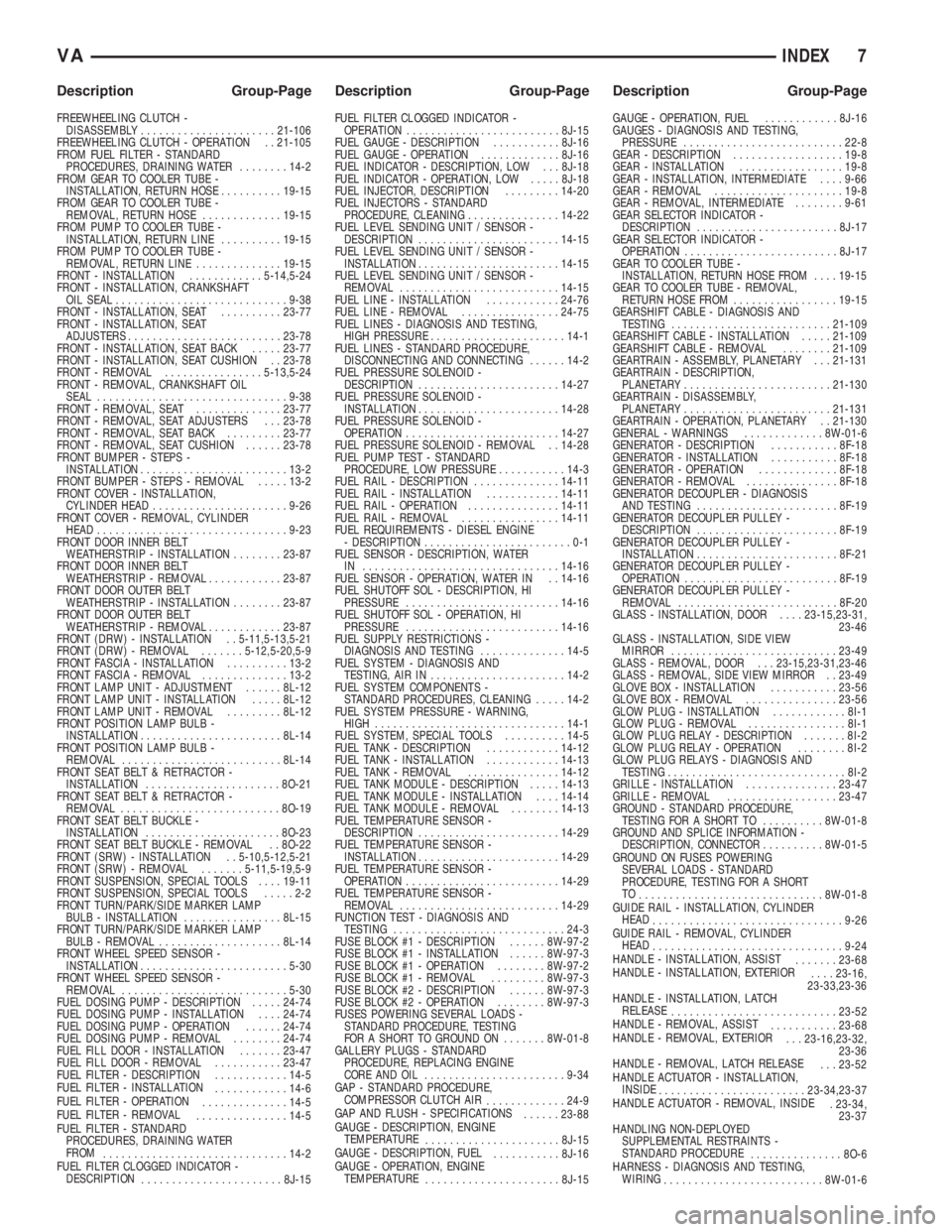
FREEWHEELING CLUTCH -
DISASSEMBLY......................21-106
FREEWHEELING CLUTCH - OPERATION . . 21-105
FROM FUEL FILTER - STANDARD
PROCEDURES, DRAINING WATER........14-2
FROM GEAR TO COOLER TUBE -
INSTALLATION, RETURN HOSE..........19-15
FROM GEAR TO COOLER TUBE -
REMOVAL, RETURN HOSE.............19-15
FROM PUMP TO COOLER TUBE -
INSTALLATION, RETURN LINE..........19-15
FROM PUMP TO COOLER TUBE -
REMOVAL, RETURN LINE..............19-15
FRONT - INSTALLATION............5-14,5-24
FRONT - INSTALLATION, CRANKSHAFT
OIL SEAL............................9-38
FRONT - INSTALLATION, SEAT..........23-77
FRONT - INSTALLATION, SEAT
ADJUSTERS.........................23-78
FRONT - INSTALLATION, SEAT BACK.....23-77
FRONT - INSTALLATION, SEAT CUSHION . . 23-78
FRONT - REMOVAL................5-13,5-24
FRONT - REMOVAL, CRANKSHAFT OIL
SEAL...............................9-38
FRONT - REMOVAL, SEAT..............23-77
FRONT - REMOVAL, SEAT ADJUSTERS . . . 23-78
FRONT - REMOVAL, SEAT BACK.........23-77
FRONT - REMOVAL, SEAT CUSHION......23-78
FRONT BUMPER - STEPS -
INSTALLATION........................13-2
FRONT BUMPER - STEPS - REMOVAL.....13-2
FRONT COVER - INSTALLATION,
CYLINDER HEAD......................9-26
FRONT COVER - REMOVAL, CYLINDER
HEAD...............................9-23
FRONT DOOR INNER BELT
WEATHERSTRIP - INSTALLATION........23-87
FRONT DOOR INNER BELT
WEATHERSTRIP - REMOVAL............23-87
FRONT DOOR OUTER BELT
WEATHERSTRIP - INSTALLATION........23-87
FRONT DOOR OUTER BELT
WEATHERSTRIP - REMOVAL............23-87
FRONT (DRW) - INSTALLATION . . 5-11,5-13,5-21
FRONT (DRW) - REMOVAL.......5-12,5-20,5-9
FRONT FASCIA - INSTALLATION..........13-2
FRONT FASCIA - REMOVAL..............13-2
FRONT LAMP UNIT - ADJUSTMENT......8L-12
FRONT LAMP UNIT - INSTALLATION.....8L-12
FRONT LAMP UNIT - REMOVAL.........8L-12
FRONT POSITION LAMP BULB -
INSTALLATION.......................8L-14
FRONT POSITION LAMP BULB -
REMOVAL..........................8L-14
FRONT SEAT BELT & RETRACTOR -
INSTALLATION......................8O-21
FRONT SEAT BELT & RETRACTOR -
REMOVAL..........................8O-19
FRONT SEAT BELT BUCKLE -
INSTALLATION......................8O-23
FRONT SEAT BELT BUCKLE - REMOVAL . . 8O-22
FRONT (SRW) - INSTALLATION . . 5-10,5-12,5-21
FRONT (SRW) - REMOVAL.......5-11,5-19,5-9
FRONT SUSPENSION, SPECIAL TOOLS....19-11
FRONT SUSPENSION, SPECIAL TOOLS.....2-2
FRONT TURN/PARK/SIDE MARKER LAMP
BULB - INSTALLATION................8L-15
FRONT TURN/PARK/SIDE MARKER LAMP
BULB - REMOVAL....................8L-14
FRONT WHEEL SPEED SENSOR -
INSTALLATION........................5-30
FRONT WHEEL SPEED SENSOR -
REMOVAL...........................5-30
FUEL DOSING PUMP - DESCRIPTION.....24-74
FUEL DOSING PUMP - INSTALLATION....24-74
FUEL DOSING PUMP - OPERATION......24-74
FUEL DOSING PUMP - REMOVAL........24-74
FUEL FILL DOOR - INSTALLATION.......23-47
FUEL FILL DOOR - REMOVAL...........23-47
FUEL FILTER - DESCRIPTION............14-5
FUEL FILTER - INSTALLATION
............14-6
FUEL FILTER - OPERATION
..............14-5
FUEL FILTER - REMOVAL
...............14-5
FUEL FILTER - STANDARD
PROCEDURES, DRAINING WATER
FROM
..............................14-2
FUEL FILTER CLOGGED INDICATOR -
DESCRIPTION
.......................8J-15FUEL FILTER CLOGGED INDICATOR -
OPERATION.........................8J-15
FUEL GAUGE - DESCRIPTION...........8J-16
FUEL GAUGE - OPERATION.............8J-16
FUEL INDICATOR - DESCRIPTION, LOW . . . 8J-18
FUEL INDICATOR - OPERATION, LOW.....8J-18
FUEL INJECTOR, DESCRIPTION.........14-20
FUEL INJECTORS - STANDARD
PROCEDURE, CLEANING...............14-22
FUEL LEVEL SENDING UNIT / SENSOR -
DESCRIPTION.......................14-15
FUEL LEVEL SENDING UNIT / SENSOR -
INSTALLATION.......................14-15
FUEL LEVEL SENDING UNIT / SENSOR -
REMOVAL..........................14-15
FUEL LINE - INSTALLATION............24-76
FUEL LINE - REMOVAL................24-75
FUEL LINES - DIAGNOSIS AND TESTING,
HIGH PRESSURE......................14-1
FUEL LINES - STANDARD PROCEDURE,
DISCONNECTING AND CONNECTING......14-2
FUEL PRESSURE SOLENOID -
DESCRIPTION.......................14-27
FUEL PRESSURE SOLENOID -
INSTALLATION.......................14-28
FUEL PRESSURE SOLENOID -
OPERATION.........................14-27
FUEL PRESSURE SOLENOID - REMOVAL . . 14-28
FUEL PUMP TEST - STANDARD
PROCEDURE, LOW PRESSURE...........14-3
FUEL RAIL - DESCRIPTION..............14-11
FUEL RAIL - INSTALLATION............14-11
FUEL RAIL - OPERATION...............14-11
FUEL RAIL - REMOVAL................14-11
FUEL REQUIREMENTS - DIESEL ENGINE
- DESCRIPTION........................0-1
FUEL SENSOR - DESCRIPTION, WATER
IN ................................14-16
FUEL SENSOR - OPERATION, WATER IN . . 14-16
FUEL SHUTOFF SOL - DESCRIPTION, HI
PRESSURE.........................14-16
FUEL SHUTOFF SOL - OPERATION, HI
PRESSURE.........................14-16
FUEL SUPPLY RESTRICTIONS -
DIAGNOSIS AND TESTING..............14-5
FUEL SYSTEM - DIAGNOSIS AND
TESTING, AIR IN......................14-2
FUEL SYSTEM COMPONENTS -
STANDARD PROCEDURES, CLEANING.....14-2
FUEL SYSTEM PRESSURE - WARNING,
HIGH...............................14-1
FUEL SYSTEM, SPECIAL TOOLS..........14-5
FUEL TANK - DESCRIPTION............14-12
FUEL TANK - INSTALLATION............14-13
FUEL TANK - REMOVAL...............14-12
FUEL TANK MODULE - DESCRIPTION.....14-13
FUEL TANK MODULE - INSTALLATION....14-14
FUEL TANK MODULE - REMOVAL........14-13
FUEL TEMPERATURE SENSOR -
DESCRIPTION.......................14-29
FUEL TEMPERATURE SENSOR -
INSTALLATION.......................14-29
FUEL TEMPERATURE SENSOR -
OPERATION.........................14-29
FUEL TEMPERATURE SENSOR -
REMOVAL..........................14-29
FUNCTION TEST - DIAGNOSIS AND
TESTING............................24-3
FUSE BLOCK #1 - DESCRIPTION......8W-97-2
FUSE BLOCK #1 - INSTALLATION......8W-97-3
FUSE BLOCK #1 - OPERATION........8W-97-2
FUSE BLOCK #1 - REMOVAL.........8W-97-3
FUSE BLOCK #2 - DESCRIPTION......8W-97-3
FUSE BLOCK #2 - OPERATION........8W-97-3
FUSES POWERING SEVERAL LOADS -
STANDARD PROCEDURE, TESTING
FOR A SHORT TO GROUND ON.......8W-01-8
GALLERY PLUGS - STANDARD
PROCEDURE, REPLACING ENGINE
CORE AND OIL.......................9-34
GAP - STANDARD PROCEDURE,
COMPRESSOR CLUTCH AIR
.............24-9
GAP AND FLUSH - SPECIFICATIONS
......23-88
GAUGE - DESCRIPTION, ENGINE
TEMPERATURE
......................8J-15
GAUGE - DESCRIPTION, FUEL
...........8J-16
GAUGE - OPERATION, ENGINE
TEMPERATURE
......................8J-15GAUGE - OPERATION, FUEL............8J-16
GAUGES - DIAGNOSIS AND TESTING,
PRESSURE..........................22-8
GEAR - DESCRIPTION..................19-8
GEAR - INSTALLATION.................19-8
GEAR - INSTALLATION, INTERMEDIATE....9-66
GEAR - REMOVAL.....................19-8
GEAR - REMOVAL, INTERMEDIATE........9-61
GEAR SELECTOR INDICATOR -
DESCRIPTION.......................8J-17
GEAR SELECTOR INDICATOR -
OPERATION.........................8J-17
GEAR TO COOLER TUBE -
INSTALLATION, RETURN HOSE FROM....19-15
GEAR TO COOLER TUBE - REMOVAL,
RETURN HOSE FROM.................19-15
GEARSHIFT CABLE - DIAGNOSIS AND
TESTING..........................21-109
GEARSHIFT CABLE - INSTALLATION.....21-109
GEARSHIFT CABLE - REMOVAL........21-109
GEARTRAIN - ASSEMBLY, PLANETARY . . . 21-131
GEARTRAIN - DESCRIPTION,
PLANETARY........................21-130
GEARTRAIN - DISASSEMBLY,
PLANETARY........................21-131
GEARTRAIN - OPERATION, PLANETARY . . 21-130
GENERAL - WARNINGS.............8W-01-6
GENERATOR - DESCRIPTION...........8F-18
GENERATOR - INSTALLATION...........8F-18
GENERATOR - OPERATION.............8F-18
GENERATOR - REMOVAL...............8F-18
GENERATOR DECOUPLER - DIAGNOSIS
AND TESTING.......................8F-19
GENERATOR DECOUPLER PULLEY -
DESCRIPTION.......................8F-19
GENERATOR DECOUPLER PULLEY -
INSTALLATION.......................8F-21
GENERATOR DECOUPLER PULLEY -
OPERATION.........................8F-19
GENERATOR DECOUPLER PULLEY -
REMOVAL..........................8F-20
GLASS - INSTALLATION, DOOR....23-15,23-31,
23-46
GLASS - INSTALLATION, SIDE VIEW
MIRROR...........................23-49
GLASS - REMOVAL, DOOR . . . 23-15,23-31,23-46
GLASS - REMOVAL, SIDE VIEW MIRROR . . 23-49
GLOVE BOX - INSTALLATION...........23-56
GLOVE BOX - REMOVAL...............23-56
GLOW PLUG - INSTALLATION............8I-1
GLOW PLUG - REMOVAL................8I-1
GLOW PLUG RELAY - DESCRIPTION.......8I-2
GLOW PLUG RELAY - OPERATION........8I-2
GLOW PLUG RELAYS - DIAGNOSIS AND
TESTING.............................8I-2
GRILLE - INSTALLATION...............23-47
GRILLE - REMOVAL..................23-47
GROUND - STANDARD PROCEDURE,
TESTING FOR A SHORT TO..........8W-01-8
GROUND AND SPLICE INFORMATION -
DESCRIPTION, CONNECTOR..........8W-01-5
GROUND ON FUSES POWERING
SEVERAL LOADS - STANDARD
PROCEDURE, TESTING FOR A SHORT
TO
..............................8W-01-8
GUIDE RAIL - INSTALLATION, CYLINDER
HEAD
...............................9-26
GUIDE RAIL - REMOVAL, CYLINDER
HEAD
...............................9-24
HANDLE - INSTALLATION, ASSIST
.......23-68
HANDLE - INSTALLATION, EXTERIOR
....23-16,
23-33,23-36
HANDLE - INSTALLATION, LATCH
RELEASE
...........................23-52
HANDLE - REMOVAL, ASSIST
...........23-68
HANDLE - REMOVAL, EXTERIOR
. . . 23-16,23-32,
23-36
HANDLE - REMOVAL, LATCH RELEASE
. . . 23-52
HANDLE ACTUATOR - INSTALLATION,
INSIDE
........................23-34,23-37
HANDLE ACTUATOR - REMOVAL, INSIDE
. 23-34,
23-37
HANDLING NON-DEPLOYED
SUPPLEMENTAL RESTRAINTS -
STANDARD PROCEDURE
...............8O-6
HARNESS - DIAGNOSIS AND TESTING,
WIRING
..........................8W-01-6
VAINDEX 7
Description Group-Page Description Group-Page Description Group-Page